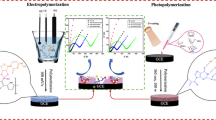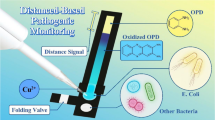Abstract
In this study, a molecularly imprinted polymer capable of recognizing 15 sulfonamides was first synthesized with sulfabenz as the dummy template. The calculation results from computation simulation showed that the specific 3D conformation of the template had an important influence on the polymer’s recognition ability. Then, the polymer was used as recognition reagent to prepare a chemiluminescence sensor on a conventional 96-well microplate for the determination of the residues of 15 sulfonamides in meat (chicken and pork). Due to the 4-(imidazol-1-yl)phenol-enhanced luminol–H2O2 system, the limits of detection for the 15 analytes were in the range of 1.0–12 pg/mL. The recoveries from the standard fortified blank samples were in the range of 72.7–99%. Furthermore, one assay could be finished within 30 min, and the sensor could be reused 4 times. Therefore, this sensor could be used as a very useful tool for routine screening of residues of sulfonamides in meat samples.

Assay procedures of the molecularly imprinted polymer-based chemiluminescence sensor for determination of sulfonamides.







Similar content being viewed by others
References
Ministry of Agriculture of China. 2002 Regulation no. 235 of Ministry of Agriculture, Peoples Republic of China
European Commission. Off J Eur Union. 1999;60:16–52.
Dmitrienko SG, Kochuk EV, Apyari VV, Tolmacheva VV, Zolotov YA. Recent advances in sample preparation techniques and methods of sulfonamides detection—a review. Anal Chim Acta. 2014;850:6–25.
Sakharov IYU, Berlina AN, Zherdev AV, Dzantiev BB. Advantages of soybean peroxidase over horseradish peroxidase as the enzyme label in chemiluminescent enzyme-linked immunosorbent assay of sulfamethoxypyridazine. J Agric Food Chem. 2010;58:3284–9.
Wu Y, Yu S, Yu F, Yan N, Qu L, Zhang H. Chemiluminescence enzyme immunoassay for the determination of sulfamethoxydiazine. Spectrochim Acta A. 2011;81:544–7.
Wutz K, Niessner R, Seidel M. Simultaneous determination of four different antibiotic residues in honey by chemiluminescence multianalyte chip immunoassays. Microchim Acta. 2011;173:1–9.
Du J. Molecular imprinting-based chemiluminescence techniques in pharmaceutical analysis. Curr Pharm Anal. 2010;6:30–8.
Shi X, Meng Y, Liu J, Sun A, Li D, Yao C, et al. Group-selective molecularly imprinted polymer solid-phase extraction for the simultaneous determination of six sulfonamides in aquaculture products. J Chromatogr B. 2011;879:1071–6.
Xu Z, Song C, Hu Y, Li G. Molecularly imprinted stir bar sorptive extraction coupled with high performance liquid chromatography for trace analysis of sulfa drugs in complex samples. Talanta. 2011;85:97–103.
Kong X, Gao R, He X, Chen L, Zhang Y. Synthesis and characterization of the core-shell magnetic molecularly imprinted polymers (Fe3O4@MIPs) adsorbents for effective extraction and determination of sulfonamides in the poultry feed. J Chromatogr A. 2012;1245:8–16.
Zhao YG, Zhou LX, Pan SD, Zhan PP, Chen XH, et al. Fast determination of 22 sulfonamides from chicken breast muscleusing core–shell nanoring amino-functionalized superparamagnetic molecularly imprinted polymer followed by liquidchromatography-tandem mass spectrometry. J Chromatogr A. 2014;1345:17–28.
Díaz-Álvarez M, Barahona F, Turiel E, Martín-Esteban A. Supported liquid membrane-protected molecularly imprinted beads for micro-solid phase extraction of sulfonamides in environmental waters. J Chromatogr A. 2014;1357:158–64.
Karimi M, Aboufazeli F, Zhad H, Sadeghi O, Najafi E. Determination of sulfonamides in chicken meat by magnetic molecularly imprinted polymer coupled to HPLC-UV. Food Anal Methods. 2014;7:73–80.
Qin SL, Su LQ, Wang P, Gao Y. Rapid and selective extraction of multiple sulfonamides from aqueous samples based on Fe3O4-chitosan molecularly imprinted polymers. Anal Methods. 2015;7:8704–13.
Zamora-Galvez A, Ait-Lahcen A, Mercante LA, Morales-Narvaez E, Amine A, Merkoci A. Molecularly imprinted polymer-decorated magnetite nanoparticles for selective sulfonamide detection. Anal Chem. 2016;88:3578–84.
Wang GN, Zhang L, Song YP, Liu JX, Wang JP. Application of molecularly imprinted polymer based matrix solid phase dispersion for determination of fluoroquinolones, tetracyclines and sulfonamides in meat. J Chromatogr B. 2017;1065(1066):104–11.
Song YP, Zhang L, Wang GN, Liu JX, Liu J, Wang JP. Dual-dummy-template molecularly imprinted polymer combining ultra performance liquid chromatography for determination of fluoroquinolones and sulfonamides in pork and chicken muscle. Food Control. 2017;82:233–42.
Hu YF, Wang C, Li XD, Liu LF. Preparation and application of epitope magnetic molecularly imprinted polymers for enrichment of sulfonamide antibiotics in water. Electrophoresis. 2017;38:2462–7.
Xu Y, Li J, Jiang L, Li Z, Li Y, Ding L. Simultaneous determination of sulfonamides and fluoroquinolones from environmental water based on magnetic double-template molecularly imprinting technique. Environ Sci Pollut Res. 2018;25:16121–34.
Kechagia M, Samanidou V, Kabir A, Furton KG. One-pot synthesis of a multi-template molecularly imprinted polymer for the extraction of six sulfonamide residues from milk before high-performance liquid chromatography with diode array detection. J Sep Sci. 2018;41:723–31.
Gao R, Zhang J, He X, Chen L, Zhang Y. Selective extraction of sulfonamides from food by use of silica-coated molecularly imprinted polymer nanospheres. Anal Bioanal Chem. 2010;398:451–61.
Mao X, Sun H, He X, Chen L, Zhang Y. Well-defined sulfamethazine-imprinted magnetic nanoparticles via surface-initiated atom transfer radical polymerization for highly selective enrichment of sulfonamides in food samples. Anal Methods. 2015;7:4708–16.
Zhao Y, Bi C, He X, Chen L, Zhang Y. Preparation of molecularly imprinted polymers based on magnetic carbon nanotubes for determination of sulfamethoxazole in food samples. RSC Adv. 2015;5:70309–18.
Lu F, Li H, Sun M, Fan L, Qiu H, Li X, et al. Flow injection chemiluminescence sensor based on core-shell magnetic molecularly imprinted nanoparticles for determination of sulfadiazine. Anal Chim Acta. 2012;718:84–91.
Qiu H, Fan L, Li X, Li L, Sun M, Luo C. Determination sulfamethoxazole based chemiluminescence and chitosan/graphene oxide-molecularly imprinted polymers. Carbohydr Polym. 2013;92:394–9.
Peng D, Li Z, Wang Y, Liu Z, Sheng F, Yuan Z. Enzyme-linked immunoassay based on imprinted microspheres for the detection of sulfamethazine residue. J Chromatogr A. 2017;1506:9–17.
Xia WQ, Huang J, Wang GN, Liu J, Wang JP. Molecularly imprinted polymer based microtiter chemiluminescence array for determination of phenothiazines and benzodiazepines in pork. Anal Biochem. 2018;554:9–15.
Zhang T, Liu J, Wang JP. Preparation of molecularly imprinted polymer based chemiluminescence sensor for determination of amantadine and rimantadine in meat. Anal Methods. 2018;10:5025–31.
Feng MX, Wang GN, Yang K, Liu HZ, Wang JP. Molecularly imprinted polymer-high performance liquid chromatography for the determination of tetracycline drugs in animal derived foods. Food Control. 2016;69:171–6.
Franek M, Diblikova I, Cernoch I, Vass M, Hruska K. Broad-specificity immunoassays for sulfonamide detection: immunochemical strategy for generic antibodies and competitors. Anal Chem. 2006;78:1559–67.
Wang Z, Beier RC, Sheng Y, Zhang S, Jiang W, Wang Z, et al. Monoclonal antibodies with group specificity toward sulfonamides: selection of hapten and antibody selectivity. Anal Bioanal Chem. 2013;405:4027–37.
Mayes AG, Whitcombe MJ. Synthetic strategies for the generation of molecularly imprinted. Adv Drug Deliv Rev. 2005;57:1742–78.
Tiwari MP, Prasad A. Molecularly imprinted polymer based enantioselective sensing devices: a review. Anal Chim Acta. 2015;853:1–18.
Kubo T, Otsuka K. Recent progress in molecularly imprinted media by new preparation concepts and methodological approaches for selective separation of targeting compounds. TrAC-Trend Anal Chem. 2016;81:102–9.
Ansari S, Karimi M. Novel developments and trends of analytical methods for drug analysis in biological and environmental samples by molecularly imprinted polymers. TrAC-Trend Anal Chem. 2017;89:146–62.
Yusakul G, Udomsin O, Tanaka H, Morimoto S, Juengwatanatrakul T, Putalun W. Enzyme-linked immunosorbent assay by enhanced chemiluminescence detection for the standardization of estrogenic miroestrol in Pueraria candollei Graham ex Benth. Luminescence. 2015;30:568–75.
Yang L, Jin M, Du P, Chen G, Zhang C, Wang J, et al. Study on enhancement principle and stabilization for the luminol-H2O2-HRP chemiluminescence system. PLoS One. 2015;10:e0131193.
Funding
The authors are grateful for the financial support from Hebei Key Research and Development Project (18226628D), Hebei Layer/Broiler Industry Technology System (HBCT2018150210), and Beijing Municipal Natural Science Foundation (6182019).
Author information
Authors and Affiliations
Corresponding author
Ethics declarations
This article does not contain any studies with humans or animals performed by any of the authors.
Conflict of interest
The authors declare that they have no conflict of interest.
Additional information
Publisher’s note
Springer Nature remains neutral with regard to jurisdictional claims in published maps and institutional affiliations.
Rights and permissions
About this article
Cite this article
Li, Z.B., Liu, J., Liu, J.X. et al. Determination of sulfonamides in meat with dummy-template molecularly imprinted polymer-based chemiluminescence sensor. Anal Bioanal Chem 411, 3179–3189 (2019). https://doi.org/10.1007/s00216-019-01792-4
Received:
Revised:
Accepted:
Published:
Issue Date:
DOI: https://doi.org/10.1007/s00216-019-01792-4




